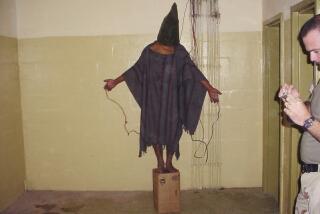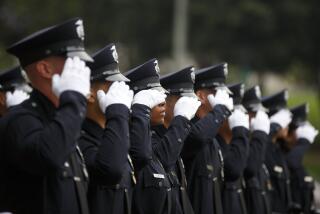Release the torture photos
- Share via
The release of dozens of new, graphic images of detainees being abused by their American captors would almost certainly reignite international rage. It could lead to an angry backlash in the Middle East and to more jihadi recruits, as the Abu Ghraib photographs did in 2004. It could even lead to new outbursts of violence at a moment when the Obama administration was finally hoping to put the last eight ugly years behind us.
But the truth must out. The Pentagon was right when it agreed last month to abide by a judge’s order and release the photos, in a case brought by the American Civil Liberties Union. And President Obama was wrong Wednesday when he reversed that position.
It’s terrible that the president was faced with such an unpalatable choice, but it’s just one of the many awful results of the culture of torture and lawlessness put in place by the Bush administration. This country has already alienated allies and seen its moral standing crumble. Now, as we try to get to the bottom of what happened during those years, we have to acknowledge that doing so might put us in further danger.
Obama’s announcement that he would seek to bar the release of the photos came after Gens. Ray Odierno, David McKiernan and David Petraeus all expressed concern that releasing them could cost American lives. A Pentagon spokesman said they believe it’s the “last thing we need” at this critical moment in Afghanistan.
But what’s the alternative? For one thing, it will be very difficult to keep the photos under wraps at this point. Shouldn’t the administration at least get credit for making them public, rather than waiting for them to be leaked to Seymour Hersh (as the Abu Ghraib pictures were)?
What’s more, the judges in the case -- both in District Court and at the appellate level -- have already rejected the government’s argument about the danger to soldiers. The judges saw at least some of the photos.
Like most Americans, we have not yet seen the images and don’t know what they’ll portray. But until they’re made public, they seem likely only to inflame the imaginations of America’s friends and enemies. The worst will be assumed. And let’s not forget Obama’s promise, on his second day in office, to “hold myself as president to a new standard of openness.”
Photographs are part of the historical record. Think of these images: black men hanging from trees in the American South; emaciated concentration camp survivors; prisoners shackled into cramped “tiger cages” in South Vietnam. Would this be a better world without those photos?
Trying to cover up atrocities because someone might be angry isn’t right and won’t work. Instead, the Pentagon should release the photos while making it clear that the U.S. repudiates such barbaric behavior and is committed to dismantling the culture that allowed it to occur.
More to Read
Sign up for Essential California
The most important California stories and recommendations in your inbox every morning.
You may occasionally receive promotional content from the Los Angeles Times.










